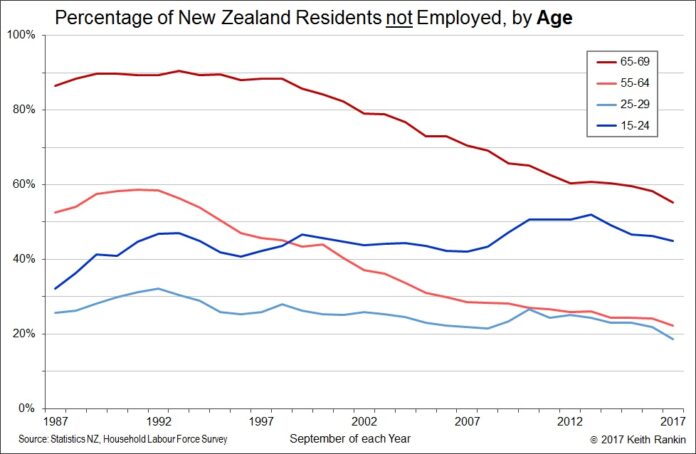Keith Rankin Analysis: Chart for this Month: Leisure by Selected Age Groups
Once upon a time we regarded market-work as a necessary evil, and we anticipated a future reward, in the form of a leisure-dividend. From the 1850s to the 1970s, the idea of a good life included the notion that there would be a release from market labour; indeed, this was considered the whole point of raising our productivity in work.
The leisure-dividend would be a release well before the ultimate release of death, a release that would enable us to give meaning and identity to our lives separate from the identity etched upon us through our occupations and careers.
Once upon a time we worked to live. We used to see leisure as a solution. Now we live to work. Has leisure become a problem? Or maybe our youth are grabbing their leisure dividends early, as older people forfeit theirs? Leisure now or never might be their motto.
This month’s chart shows that 90% of 65-69 year-olds were free from market labour, but in 2017 only 55% are enjoying such freedom. The decline started in the late 1990s, around the time that the retirement discourse shifted. Fulltime retirement came to be framed, increasingly, as an unaffordable indulgence. The likelihood is that the pattern will continue; in part because for some people the love of money has become greater than the love of free-time, and in part because low and precarious incomes force many people to live extended market lives.
For 55-64 year-olds, retirement peaked at 59% during the unemployment crisis of the early 1990s. After that, as the age of entitlement to public superannuation was raised to 65, a rapid decline in retirement set in. Now 25 years after the peak, only 22% of 55-64 year-olds are retired or otherwise out of work.
Neither of the older age groups increased their leisure after the global financial crisis. Rather older people clung onto their jobs, leaving those in their twenties to pay the unemployment price.
While people aged 25-29 enjoy less leisure now than before, the leisure they do experience would appear to be enforced; it is correlated to periods of high unemployment.
For 15-24 year-olds, their fulltime non-employment, which exceeded 50% from 2010 to 2013, shows what must be understood as a remorseless upward trend. Certainly it is not clear that young people need more education than they did in the past. Non-employment in this age group is now as high as it was in the early 1990s, when the young truly experienced mass unemployment on a scale comparable with the depression of the 1930s.
On the upside, some young people may be taking genuine leisure dividends early, on the understanding that the option of a leisure dividend later in life may be closed to them. Others may have dropped-out of any serous expectation of a 40-year-life of paid labour. The epidemic of mental illness among young people surely must be related to the rising proportion who see little hope of leading a life of economic independence. Older people clinging onto their jobs must have contributed to the reduction of opportunities for unexceptional young people to build careers.
So the general picture is one of older people foregoing leisure dividends. And of younger people foregoing economic independence and the responsibilities that such independence entails. Deep down they know that, as they themselves move into middle-age, they will be expected to produce but not consume the goods and services that their collective elders will demand of them.








